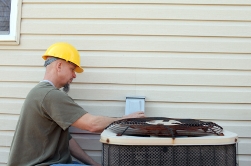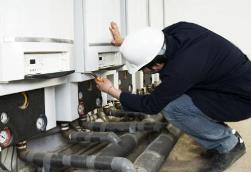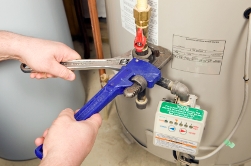How to Find the Right HVAC Training Class near Buffalo South Dakota
 Once you have come to a decision on a career as a heating and air conditioning technician, the next step is to locate an HVAC technical school near Buffalo SD. But with so many to choose from, how do you decide on the right one to obtain the training that you need? Many potential students will make their decision based entirely on the price of tuition or how close the school is to their residence. Even though these are significant considerations, they are not the only ones to evaluate. Some of the other things that you need to look into are the graduation rates of the HVAC schools, their reputations, and if they are accredited by professional trade organizations. These and other criteria will be addressed in more detail later within this article. But before we examine how to choose an HVAC technical school, let’s take a look at what a heating and air conditioning contractor does to become a licensed professional tradesman.
Once you have come to a decision on a career as a heating and air conditioning technician, the next step is to locate an HVAC technical school near Buffalo SD. But with so many to choose from, how do you decide on the right one to obtain the training that you need? Many potential students will make their decision based entirely on the price of tuition or how close the school is to their residence. Even though these are significant considerations, they are not the only ones to evaluate. Some of the other things that you need to look into are the graduation rates of the HVAC schools, their reputations, and if they are accredited by professional trade organizations. These and other criteria will be addressed in more detail later within this article. But before we examine how to choose an HVAC technical school, let’s take a look at what a heating and air conditioning contractor does to become a licensed professional tradesman.
[campusexplorer header_text=”Find HVAC Training Schools Near You!” aos=”53237562″ concentration=”16D42C74″ tracking=”HVAC-D”]
Becoming an HVAC Technician in Buffalo SD
 HVAC is an acronym that is extensively used in the trade that stands for “Heating, Ventilation and Air Conditioning”. HVAC technicians specialize in the installation, maintenance and repair of air conditioners, furnaces, boilers, hot water heaters and heating systems. As skilled tradesmen, they are generally required to be licensed, though each state and local municipality has its own criteria. Acquiring professional certification is not compulsory, but an alternative way for Buffalo SD HVAC specialists to prove that they are highly skilled and accomplished in their area of expertise. There are a number of recognized certifications within the industry that are available. Here are a few of the significant ones.
HVAC is an acronym that is extensively used in the trade that stands for “Heating, Ventilation and Air Conditioning”. HVAC technicians specialize in the installation, maintenance and repair of air conditioners, furnaces, boilers, hot water heaters and heating systems. As skilled tradesmen, they are generally required to be licensed, though each state and local municipality has its own criteria. Acquiring professional certification is not compulsory, but an alternative way for Buffalo SD HVAC specialists to prove that they are highly skilled and accomplished in their area of expertise. There are a number of recognized certifications within the industry that are available. Here are a few of the significant ones.
- North American Technician Excellence (NATE). NATE is a nationally acknowledged certification for HVAC technicians. The certification is earned by passing a proficiency examination and can be received in one or more specialties.
- HVAC Excellence. This certification makes available both a professional and a master specialist credential. Two years of professional experience together with passing a comprehensive exam are required for the professional level certification. Master specialists must have 3 years of experience in addition to a passing result on the professional level exam. Similar to NATE, certifications are provided in several specialties.
- EPA Section 608. This certification is necessary for specialists that handle refrigerants. There are 3 types of certification available, one for small appliances, and the additional two for low and high pressure refrigerants.
Considering that licensing might be mandated in your area, and you may also desire to earn certification, it’s imperative that you select an HVAC trade school that will prepare you for both. And since you will most likely be working with refrigerants, make certain that the program you choose preps you for passing the EPA Section 608 exams.
HVAC Degree Classes
 There are a variety of alternatives available for HVAC instruction in a vocational or trade school. You can attain a certificate, an Associate Degree, or a Bachelor’s Degree. Earning a certificate will take the least amount of time, often accomplished in as little as six months, though some programs are longer. A certificate will qualify you for most HVAC positions, particularly if you are licensed and have certification relevant to the position. The degree training programs can provide a competitive edge in the job market and will provide more extensive training than the certificate programs. Below is a short explanation of each credential offered near Buffalo SD.
There are a variety of alternatives available for HVAC instruction in a vocational or trade school. You can attain a certificate, an Associate Degree, or a Bachelor’s Degree. Earning a certificate will take the least amount of time, often accomplished in as little as six months, though some programs are longer. A certificate will qualify you for most HVAC positions, particularly if you are licensed and have certification relevant to the position. The degree training programs can provide a competitive edge in the job market and will provide more extensive training than the certificate programs. Below is a short explanation of each credential offered near Buffalo SD.
- Certificate. Usually requiring a high school diploma, certificate programs are preferred among beginning residential or commercial HVAC professionals. They furnish a solid foundation of skills for employment within the trade.
- Associate Degree. The Associate Degree in HVAC program provides a more extensive background of heating and a/c systems than the certificate program. Normally taking two years to finish, some degrees incorporate an internship or work-study program.
- Bachelor’s Degree. The Bachelor’s Degree in HVAC is tailored more towards a career in management or even business ownership. Some programs require an Associate Degree, while others are a conventional four year program. In addition to being taught how to service and maintain heating and cooling systems, you will also study how to design them.
Selecting the appropriate credential program will be dependent on what your future career aspirations are, as well as the time and money that you have to invest. One possibility is to begin with a certificate or even an Associate Degree program, and after getting some experience in the field in Buffalo SD, eventually going back to earn a Bachelor’s Degree. If this is your tactic, make certain to ask the HVAC tech school you are considering about how their returning student program works.
HVAC Training Online
 Attending an HVAC program online is one alternative in getting your training and receiving a certificate or degree. Most schools will call for some attendance on campus to take part in practical training. Some also provide internship or work-study programs in addition to or in place of practical lab work. But since the rest of the classes can be attended via the internet, this option may be a more practical solution for some Buffalo SD students that are pressed for time. And a number of online degree programs are cheaper than other traditional options. Even driving expenses from Buffalo and study materials can be minimized, helping to make schooling more affordable. And many online programs are fully accredited (more on this later). So if your career or family obligations have left you with limited time to attend classes, maybe an HVAC online training program will make it easier to accommodate school into your busy schedule.
Attending an HVAC program online is one alternative in getting your training and receiving a certificate or degree. Most schools will call for some attendance on campus to take part in practical training. Some also provide internship or work-study programs in addition to or in place of practical lab work. But since the rest of the classes can be attended via the internet, this option may be a more practical solution for some Buffalo SD students that are pressed for time. And a number of online degree programs are cheaper than other traditional options. Even driving expenses from Buffalo and study materials can be minimized, helping to make schooling more affordable. And many online programs are fully accredited (more on this later). So if your career or family obligations have left you with limited time to attend classes, maybe an HVAC online training program will make it easier to accommodate school into your busy schedule.
What to Ask HVAC Training Classes near Buffalo SD
Once you have selected the type of certificate or degree that you desire to obtain, either online or on campus, you can begin to decrease your list of schools. As you are probably aware, there are a large number of HVAC vocational schools in the Buffalo SD area and throughout the United States to pick from. That’s why it is extremely important to have a list of important qualifications when making school comparisons. As previously mentioned in our opening paragraph, tuition and location will undoubtedly be the first two aspects you will take into consideration. Following are several additional ones that you will want to investigate before enrolling in your school of choice.
Accreditation. Numerous HVAC trade schools in the Buffalo SD area have received either a regional or a national accreditation. They may receive Institutional Accreditation, which focuses on the school’s programs overall, or Programmatic Accreditation, which relates to an individual program, for instance HVAC technology. Make certain that the school and program are accredited by a U.S. Department of Education recognized accrediting organization, for instance the Accreditation Board for Engineering and Technology. Along with helping ensure that you obtain an excellent education, it can help in obtaining financial assistance or student loans, which are frequently unavailable for non-accredited schools. Also, many states require that the HVAC training course be accredited for it to qualify for licensing.
High Completion Rates. Ask the Heating and Air Conditioning schools you are considering what their completion rates are. The completion rate is the portion or percentage of students who enroll in and complete the course. A lower completion rate could suggest that students were disappointed with the course and dropped out. It could also suggest that the teachers were not competent to train the students. It’s similarly essential that the schools have higher job placement rates. Older and/or more reputable schools may have a more extensive directory of alumni, which can produce more contacts for the school to employ for their apprenticeship and job placement programs. A high job placement rate will not only affirm that the school has a good reputation within the field, but additionally that it has the network of Buffalo SD HVAC employers to help grads acquire apprenticeships or jobs.
Apprenticeship Programs. Many HVAC vocational programs are taught along with an internship or an apprenticeship program. Those participating trade and technical schools will help place you in an apprenticeship program inside their network of Heating and Cooling companies or trade unions. Find out if the schools you are considering have working relationships with local Buffalo SD HVAC contractors. An apprenticeship not only provides a rewarding experience by providing practical training, but it also furnishes job opportunities and helps to build relationships in the area HVAC professional community.
Modern Facilities. Confirm that the school facilities and the tools that you will be trained on are up-to-date and what you will be working with in the field. If you are currently in an internship or an apprenticeship, check with the HVAC tech you are working with concerning what you should be looking for. Otherwise, ask a local Buffalo SD HVAC contractor if they can give you some pointers. Also keep in mind that unless you are willing to move, the school needs to be within driving distance of your Buffalo SD home. Remember that if you decide to enroll in an out-of-state school, besides the added moving costs there might be increased tuition charges compared to in-state residents.
Smaller Classes. It’s desirable that you get as much individualized training as possible, which can be difficult in bigger classes. Ask if you can sit in on a couple of the classes so that you can observe how large they are and experience the interaction between instructors and students. Speak with several of the students and get their feedback regarding class sizes and instruction. Finally, talk with some of the instructors and find out what their level of experience is and what certifications or degrees they have earned.
Flexible Scheduling. Verify that the class schedules for the programs you are evaluating are flexible enough to handle your needs. If you are only able to go to classes in the evening or on weekends near Buffalo SD, confirm that the schools you are reviewing offer those options. If you can only attend part-time, be sure that the school you select permits part-time enrollment. Also, find out what the protocol is to make-up classes should you miss any because of work, illness or family responsibilities.
Attending HVAC School near Buffalo SD?
Buffalo, South Dakota
Buffalo, South Dakota, is located at 45°35′5″N 103°32′42″W / 45.58472°N 103.54500°W / 45.58472; -103.54500 (45.584845, -103.545001).[10] According to the United States Census Bureau, the town has a total area of 0.55 square miles (1.42 km2), all of it land.[2]
As of the census[3] of 2010, there were 330 people, 168 households, and 86 families residing in the town. The population density was 600.0 inhabitants per square mile (231.7/km2). There were 220 housing units at an average density of 400.0 per square mile (154.4/km2). The racial makeup of the town was 97.3% White, 0.9% Native American, 0.3% from other races, and 1.5% from two or more races. Hispanic or Latino of any race were 1.5% of the population.
There were 168 households of which 22.0% had children under the age of 18 living with them, 41.7% were married couples living together, 7.1% had a female householder with no husband present, 2.4% had a male householder with no wife present, and 48.8% were non-families. 46.4% of all households were made up of individuals and 19.6% had someone living alone who was 65 years of age or older. The average household size was 1.96 and the average family size was 2.80.
Pick the Right HVAC Certification Training near Buffalo SD
Enrolling in the right HVAC training course is a crucial beginning toward a rewarding career in the heating and cooling industry. As we have covered in this article, you should select a school and a degree or certificate program that are both accredited and have outstanding reputations within the HVAC community. Other factors to search for are lots of practical training and state-of-the-art facilities. You should visit each of the schools in person that you are most interested in to inspect the campus and talk with both the faculty and current students. Attempt to get a feel for the quality of the training and the interaction between them. Also, ask about scheduling options and if evening or weekend classes are available if needed. And don’t forget to inquire about financial aid and student loan options also. If you ask the appropriate questions as we have laid out in our guidelines for assessing schools, you’ll be able to filter your options so that you can make an educated decision. With the appropriate training, hard work and dedication, you can ultimately become a licensed HVAC specialist in Buffalo SD.
More Fabulous Cities in South Dakota
